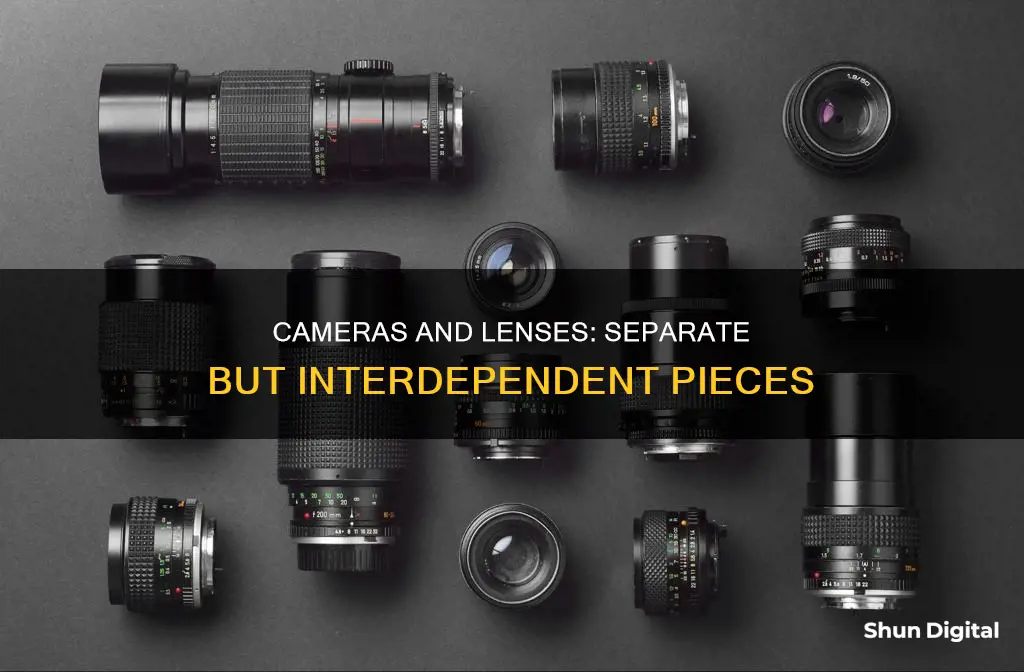
Cameras and lenses are indeed separate pieces of equipment. The lens is what focuses light from what you see through the viewfinder into a tiny spot on the back of your film, DSLR, or mirrorless camera. Without a camera lens, your camera body could not capture images. A camera lens is also more important than the camera body as it determines the aperture range, the possible depth of field, and the focusing distance.
| Characteristics | Values |
|---|---|
| Camera lenses | Focus and direct light onto the camera's image sensor or film |
| Control aspects like framing, perspective, depth of field, and the light entering the camera | |
| Can be interchangeable with specific cameras | |
| Are the most important part of a photography kit | |
| Are made up of lens elements that bend light in specific ways | |
| Have an aperture that controls the amount of light passing through | |
| Have a focal length that determines the field of view |
What You'll Learn
- Camera lenses are not interchangeable with all cameras
- Lenses are one of the most important parts of your photography kit
- A lens mount is the mechanical fitting that allows the lens to attach to the camera
- The lens release button unlocks the lens mount and allows you to detach the lens
- The lens cap protects the inner lens elements from dust and scratches

Camera lenses are not interchangeable with all cameras
Lens mounts are the parts of a camera where the lens clicks into place. Different brands often use different types of mounts. For example, Canon uses the EF mount, Nikon uses the F mount, and Sony uses the E mount. These mounts are like a unique language that determines which lenses can directly fit onto a camera.
Even within the same brand, different camera models may have different mounts. For instance, Canon introduced the EF-S-mount in 2003 for cameras with APS-C sensors, while the older EF-mount is used for its EOS range of cameras. Nikon, on the other hand, has been using the F-mount since 1959, but its 1-mount is used for its compact system cameras.
Adapters can be used to attach lenses from one brand to a camera of another brand. However, using adapters may limit lens functions and the fit may not be as secure.
The type of camera also determines lens compatibility. Lenses for DSLR cameras will not fit compact system cameras or mirrorless cameras, which have their own specific lens mounts.
In summary, camera lenses are not universally interchangeable and it is important to consider the lens mount, brand, and type of camera when choosing a lens to ensure compatibility and optimal performance.
How Lenses Transform Your Camera's Vision
You may want to see also

Lenses are one of the most important parts of your photography kit
Lenses are indeed one of the most important parts of your photography kit. They are what make photography possible in the first place, by focusing and directing light onto the camera's image sensor or film. The quality of the lens will determine the quality of the image, and a good lens will allow for a sharp photo with plenty of detail and contrast.
The lens is responsible for controlling aspects like framing, perspective, depth of field, and the light entering the camera. It is made up of multiple lens elements, or individual lenses, that are grouped together in the tube, or lens barrel. These elements work together to refract and focus light onto the camera sensor.
There are two main attributes of a camera lens: the angle of view, and the aperture. The angle of view determines how close and how wide you can get with the lens. The aperture refers to the opening of a lens diaphragm through which light passes, and it affects the depth of field and the image's exposure.
Different types of lenses are suited to different types of photography. For example, a fisheye or ultra-wide-angle lens is good for panoramic shots, landscapes, and abstract images, whereas a telephoto lens is ideal for sports or astronomy.
The selection of the right lens is important to capture perfect photos. Without a lens, you can only produce an image of white light.
The High Cost of Camera Lenses: Why So Expensive?
You may want to see also

A lens mount is the mechanical fitting that allows the lens to attach to the camera
Lens mounts are usually of three types: screw-threaded, bayonet-type, and breech-lock (friction lock). Modern still camera lens mounts are of the bayonet type, as they allow for precise alignment and a tight fit. Screw-threaded mounts, on the other hand, are fragile and cannot align the lens rotationally. Bayonet mounts have three to four tabs that lock the lens in place, with a spring-loaded pin mechanism to lock and release the lens.
The lens mount is not just a physical hole but also an interface that allows communication between the camera and the lens. This communication enables features like autofocusing and electronic control of the aperture.
Different camera manufacturers (such as Sony, Nikon, Canon, Pentax, etc.) have their own proprietary lens mounts, which are usually incompatible with each other. The lens mount also determines the flange focal distance, which is the distance between the mounting flange and the film or sensor.
The EF lens mount, for example, is Canon's standard lens mount for its EOS family of SLR film and digital cameras. It is a bayonet-style mount with electrical contacts for communication between the camera and the lens. The EF mount has a large diameter and a relatively short flange focal distance, allowing for mechanical adaptation to various non-EF lenses.
Analog Camera Lenses: Interchangeable or Not?
You may want to see also

The lens release button unlocks the lens mount and allows you to detach the lens
The lens release button is an essential component of the camera body, usually located on the side. Pressing this button allows you to detach the lens from the camera body. The lens release button unlocks the lens mount, enabling you to rotate the lens and remove it safely. This process is known as changing lenses or lens dismounting.
To detach a lens, start by turning off the camera. Then, locate and press the lens release button while rotating the lens clockwise. Continue turning the lens until the mounting index on the lens aligns with the index on the camera body. Typically, these indices are marked with little white dots that need to be lined up. Once the lens is aligned, place the rear protective cap onto the back of the lens. If you are not attaching another lens, it is good practice to cover the lens mount with the protective cap to keep it safe.
It is important to note that different camera models may have slight variations in the placement of the lens release button. Additionally, some cameras might not have a dedicated button for this function, and you may need to access it through the camera's menu.
When changing lenses, it is crucial to minimise the exposure of the camera's interior to dust and other contaminants. Always change lenses in a clean environment and ensure that the camera's power is turned off to reduce the risk of dust being attracted to the image sensor.
Universal Camera Lenses: A Myth or Reality?
You may want to see also

The lens cap protects the inner lens elements from dust and scratches
Cameras and lenses are typically sold as separate pieces of equipment. The camera body houses the sensor, while the lens is responsible for focusing and directing light onto the sensor.
Lenses are complex optical systems, and they require protection from dust, dirt, scratches, and other environmental hazards. This is where lens caps come in.
Lens caps are protective covers that fit over the front and/or rear of a camera lens. They act as a barrier against airborne particles, oily residue, moisture, and other substances that can cause damage to the glass. By covering the lens, lens caps help maintain the clarity and longevity of the camera lens, ensuring the production of high-quality images.
Lens caps are usually made of plastic, rubber, or metal, and they are designed to fit the specific size and shape of a lens. They are easy to attach and remove, and they often feature a tether or leash to prevent loss. While some photographers find lens caps annoying or cumbersome, they are essential for protecting lenses during storage and transportation.
In addition to lens caps, other lens protection options include lens hoods, UV filters, and polarizing filters, which can provide additional barriers against damage.
Camera Lenses: Expensive, Fragile, and Worthy of Insurance Coverage
You may want to see also







